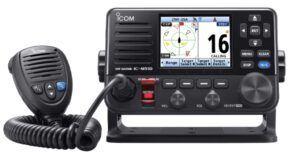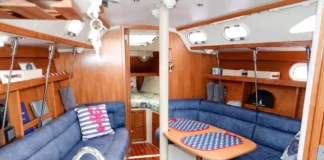In the ever-evolving realm of maritime communication, Digital Selective Calling (DSC) and Automatic Identification System (AIS) have emerged as game-changers within the latest models of fixed-base, moderately priced VHF radios.
This technology not only transforms how mariners connect at sea but also elevates response times during emergencies. VHF radios, revered as the gold standard in maritime communication, now come packed with advanced features, including distress signaling, precise position sharing, and selective calling.
SOME BACKGROUND
Digital Selective Calling (DSC) and the Automatic Identification System (AIS) are two distinct but complementary technologies.
DSC is a standard feature in modern marine VHF radios that allows for the sending of pre-defined digital messages over the medium-frequency (MF), high-frequency (HF), and very-high-frequency (VHF) maritime radio systems.

It is a core part of the Global Maritime Distress Safety System (GMDSS). DSC allows a radio operator to send a digital call, or ‘alert’, to one or more selected radio stations. This is similar to a telephone pager, sounding an alarm and leaving a basic message on the selected stations’ DSC receiver.
In an emergency, a distress alert containing essential information can be sent quickly and simply. This alert is repeatedly and rapidly transmitted on a dedicated frequency (Channel 70 for VHF DSC), ensuring that someone within the area will receive it.
MMSI AND POSITION
DSC-equipped radios are programmed with the ship’s Maritime Mobile Service Identity (MMSI) and can be connected to the ship’s GPS, which allows the apparatus to send a distress signal with the ship’s identity and position. Many VHF radios now come equipped with internal GPS receivers, making this integration much easier. A DSC alert is typically followed by a radiotelephone voice transmission on the appropriate channel, typically Channel 16 for VHF.
AUTOMATIC IDENTIFICATION SYSTEM
AIS is a communications system that uses VHF maritime mobile band channels to automatically transmit and receive ships’ data, such as identity, type, position, course, speed, and other safety-related information. AIS transponders on ships automatically broadcast information at regular intervals, including dynamic information like vessel position, heading, speed, and static information such as the ship’s name, cargo, and destination. The effective range is about 40 nautical miles.
Information provided by AIS can be displayed on a screen or an electronic chart display and information system (ECDIS), assisting in navigation and collision avoidance. Many higher-end VHF radios also offer closest point of approach (CPA) information once only available via radar. While traditional AIS has a range limited by VHF, Satellite-AIS (S-AIS) has expanded the operational capability, allowing for global vessel tracking.
In modern VHF radios, DSC and AIS are often integrated to provide a comprehensive safety and communication system. For example, a VHF radio with DSC functionality can send distress alerts with the push of a button, while the AIS receiver can show real-time vessel traffic information on the VHF display. This integration allows for enhanced situational awareness and the ability to communicate directly with specific vessels or shore stations, improving safety and efficiency.
MODERN VHF RADIOS IN USE
Ensuring safety always begins with monitoring Channel 16, where crucial safety announcements, warnings, and emergency calls unfold. But now, DSC-capable VHF radios seamlessly connect mariners, harbormasters, and emergency services. The integration of DSC capability enables the swift exchange of critical information.
Unlocking the full potential of these radios involves a simple yet vital step – registering for a Maritime Mobile Service Identity (MMSI). This unique identifier links essential information, ensuring accurate distress communication when it matters most.
DSC technology shines in improving the odds of rescue through rapid distress signal transmission. These radios not only facilitate enhanced communication but also allow calls without the need to hail on an open frequency. An alert is often complemented by a modern VHF’s GPS-enabled position transmission.
THE BIG PICTURE
As recreational boating embraces these technological advancements, marine communication technology becomes more accessible, contributing significantly to safety enhancement. DSC, an integral part of the Global Maritime Distress and Safety System, plays a pivotal role in swift distress signaling to the Coast Guard and similarly-equipped vessels. However, challenges persist, emphasizing the importance of ensuring proper DSC use, as surveys reveal distress alerts sometimes lack crucial position information.
While the effectiveness of DSC is unquestionable, misconceptions about relying on cell phones in distress situations linger. Cell phones serve as valuable backups, but they should never replace established search and rescue systems. The Coast Guard’s state-of-the-art system, Rescue 21, diligently tracks VHF/DSC transmissions, playing a crucial role in distress location and rescue efforts—a capability cell phones can’t match.
Equipping vessels with DSC/VHF radios connected to GPS units becomes a proactive approach to search and rescue, underscoring technology’s vital role in enhancing maritime safety. It’s underpinned by the Global Maritime Distress and Safety System (GMDSS), which includes safety broadcasts, Marine Assistance Request Broadcasts (MARB), Broadcast Notices to Mariners (BNTM), and Weather Radio updates.
Indeed, MMSI registration is a modern expression of the mariners’ age-old culture of offering mutual assistance in case of emergency. A well-connected boating community that prioritizes safety, adheres to communication protocols, and embraces DSC technology with MMSI registration is in the best tradition of aiding one another from the perils of the sea.









































My 2003 Jeanneau came with a VHF radio that had DSC capability. I have used this boat all along the east coast of the US, across the Atlantic, and in NW Europe for 6 years. The only time I have ever had DSC connections was once when the French douane wanted us to stop for an inspection (we did) and when we clipped the corner of an otherwise empty traffic separation scheme and were called about it from the French traffic controllers.
We also have AIS, which displays on our chart plotter. It is very valuable, and I would not go to sea without it any more.
But I still don’t know what I am supposed to do when the DSC alarm goes off, because it has only done so twice in 17 years, and the instruction manual is a magnificent jumble of words about buttons with small letters on them. In addition, the VHF is supposed to be able to transmit my position, using a GPS supplier, but I have never found any GPS that successfully talks to the VHF.
In summary, AIS is very useful, DSC is useless.